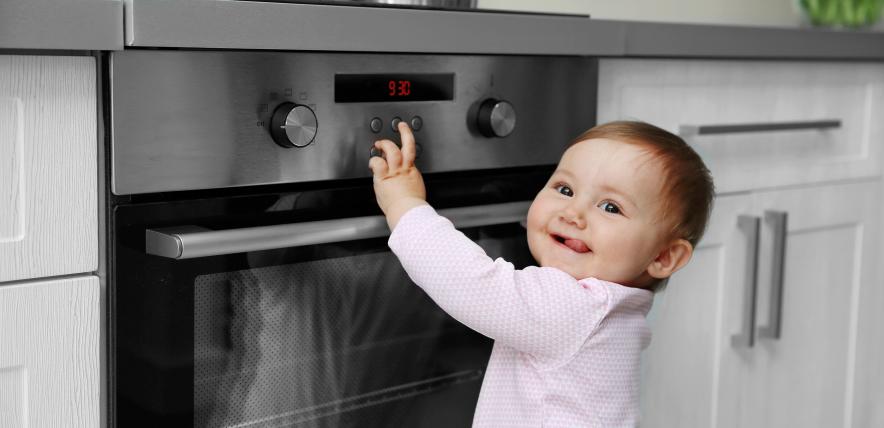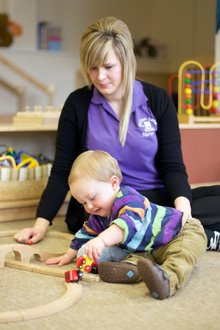It's a special time when you realise your child is beginning to be mobile, whether shuffling about on their bottom, crawling or cruising round the furniture. Maybe they have skipped those stages altogether and suddenly seem to be charging around all over the place? Whichever way your tot is moving, it marks a new and incredible phase of their development.
We all want our children to be able to explore their surroundings with all five senses and to learn about the world from their environment. While this is a wonderful time for your child as they find their early independence, it makes sense to take precautions to ensure your newly mobile tot stays safe when your back is turned.
Short of moving into a house made of sponge, there is no way to mitigate against every single potential danger in the home. When your child is small it is unlikely that he or she will spend any time without an adult nearby, but we all know that children will find a way to trip, tumble, tug or topple no matter how closely supervised, so it definitely pays to try to make your home as safe as possible. These prompts will help you ensure that you’ve done what you can to toddler proof your surroundings to so your child can explore more safely.
Basic safety
First, the obvious stuff.
Inquisitive hands can find trouble, so stow loose cables where possible – however, if you’re in the UK, it is safer not to use socket inserts, as all British plug sockets must adhere to strict regulations which have been developed with keeping children safe in mind, and socket covers can in fact make plugs less safe, not more.
Use stairgates to limit access (particularly if you have open staircases), and attach slam guards onto doors (out of reach) to safeguard little fingers.
Install cupboard locks and drawer stops where necessary, but consider that it can be enormous fun for curious toddlers to investigate the contents of the kitchen cabinets, so if you are prepared for the slight tedium of repetitive tidying, leave one harmless cupboard unlocked. That collection of empty ice cream tubs will finally find a purpose, along with any other plastic or wooden utensils - anything that won’t object to being deposited on the kitchen floor on a regular basis and won’t harm your child.
Sadly, children can become entangled in blind cords and even strangled, so ensure any blind cords are kept well out of children’s reach.
Don’t cut the blind cord to make it shorter, as this can often backfire with one cord becoming longer and increasing the risk of entanglement. Wherever possible, do not have blind cords at all. RoSPA has more detailed information on blind safety including a video.
Preventing burns
Check smoke alarms and carbon monoxide detectors regularly so you know they are working correctly, and consider the temperature of your radiators – could your child burn themselves on a radiator that is set too high? Think about turning the temperature down.
The biggest group of toddler accidents tends to be around scalds and burns – so think about where to keep heated tongs such as straighteners where your little one won’t be able to get their hands on them, as well as keeping them away from the more obvious ovens, kettles and irons. If you have an open fire, invest in a fireguard as fireplaces can pose a danger to children even if the fire is not burning – consider a fire gate/fence, which cordons off the entire fireplace and hearth, although don’t go for a freestanding screen as children can push these over or pull them down on top of themselves.
See things from your toddler’s perspective
Next, as silly as it sounds, get down on your hands and knees to experience your environment from your child’s viewpoint. Travel through your house at that level looking for anything that might tempt a newly crawling or walking adventurer. Is there anything in reach that could be pulled and topple down? Is there an unloved corner where an old pen lid or button battery is lying on the floor waiting to be choked on? Look - with your best anxious parent eyes - for anything that could be harmful. Bang in that protruding nail, remove that glass vase and tuck that cable out of sight. Apply cushioned corner protectors to any hard objects within range, and check floors for anything that could result in a trip or fall.
Think carefully about the areas in the home that hold the most hazards — usually the kitchen and the bathroom — and make sure anything that could potentially be dangerous is kept out of reach or locked away. Cleaning products, dishwasher tablets, sharp items, hot towel rails or straighteners, cosmetics and even cotton wool are all dangerous to little ones, so the kitchen and bathroom need to be scrutinised and made safe.
Make it climb-proof
One area which can often be overlooked when toddler-proofing is taller furniture such as bookcases or dressers. Bear in mind that to the newly mobile tot, climbing is the best fun. Sadly many children are injured - often fatally - by heavy furniture falling onto them when they are climbing on it or pulling it. Always attach heavy furniture to the wall securely and remember that small children love to climb. You can also consider creating ‘safe’ climbing areas for your little spider boy or girl - pillows, sofa cushions and other soft furnishings are a great way to start.
Keep the chemicals away
Be aware that certain chemical products and detergents such as laundry pods can be very harmful to little humans, and that mould and mildew are bad for growing lungs. Make sure your home is well ventilated and should any patches appear, take action to remove it and prevent it from returning.
Lastly, move your attention from safety to minimising inconvenience. Small fingers experimenting with switch-flicking could mean your freezer contents have to be chucked, or your dishwasher starts its three hour cycle all over again. To avoid such issues switch off appliances at the wall when not in use, tape switches on or off if within reach, or run the dishwasher and washing machine after bedtime.
These simple precautions can make sure your little explorer stays as safe as possible on their every day adventures.
Further information
The Royal Society for the Prevention of Accidents
Child Accident Prevention Trust
Written for the Early Years Alliance by Martha Hales.
Where next?
The dangers of button batteries








